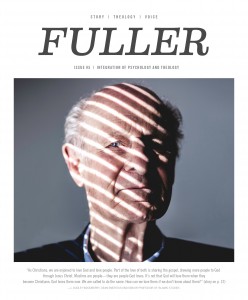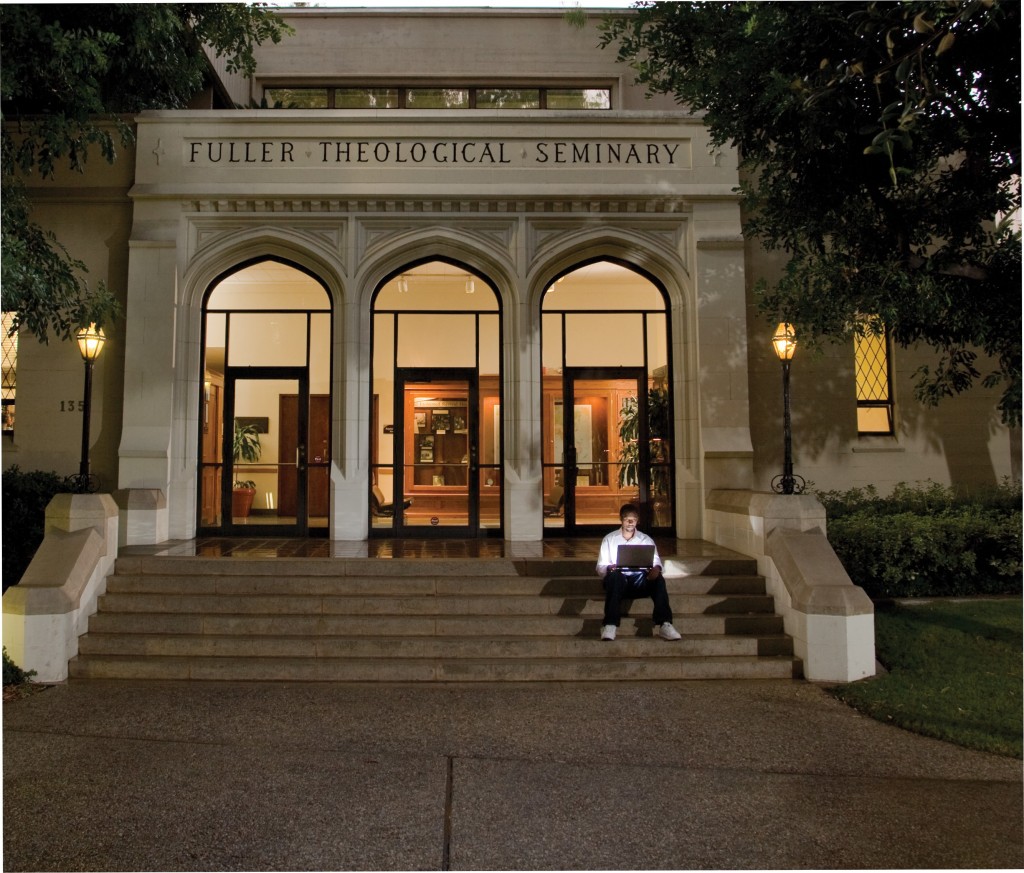
“We are the stories we tell. From the flickering flames of the campfire to the video captures of the humiliating or hilarious, stories have guided tribe and tradition. A community’s canon, whether an ancient Holy Book or a viral blog post, influences how one imagines the identity of those within their community and how the community imagines outsiders. . . . The mandate for the followers of Christ to go into all the world will not be fulfilled by riding a donkey through Jerusalem but going into the virtual spaces made available through digital technology.”
+ Joy Moore, assistant professor of preaching, in her essay “Social Media and the Church,” available here. Above: a student works on an online class in front of Fuller Pasadena’s Payton Hall.

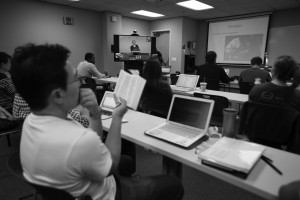 + Professor Christopher B. Hays and PhD student Anna Lo use Reflectance Transformation Imaging (RTI) to translate 4,000-year-old Sumero-Akkadian tablets from Mesopotamia for the first time into English. The technology, the result of a partnership with USC’s West Semitic Research Project, uses digital photography and multiple light sources to help them interpret the ancient surface. The artifacts “give more context for the Bible,” says Hays. “They help us understand how the ancient Babylonians lived their lives, and even what gods they worshiped.” The tablet pictured records the sale of animals for a festival, and even reveals the scribe’s fingerprints. Read Dr. Hays’s reflections on leading an immersion course in the Holy Land here.
+ Professor Christopher B. Hays and PhD student Anna Lo use Reflectance Transformation Imaging (RTI) to translate 4,000-year-old Sumero-Akkadian tablets from Mesopotamia for the first time into English. The technology, the result of a partnership with USC’s West Semitic Research Project, uses digital photography and multiple light sources to help them interpret the ancient surface. The artifacts “give more context for the Bible,” says Hays. “They help us understand how the ancient Babylonians lived their lives, and even what gods they worshiped.” The tablet pictured records the sale of animals for a festival, and even reveals the scribe’s fingerprints. Read Dr. Hays’s reflections on leading an immersion course in the Holy Land here.
+ (left) Dean Scott Sunquist is pictured leading a devotional with students at Fuller Texas as students in Phoenix and Pasadena join them through livestreaming—both a technological innovation and an image of unity stretching across geographical limitations.
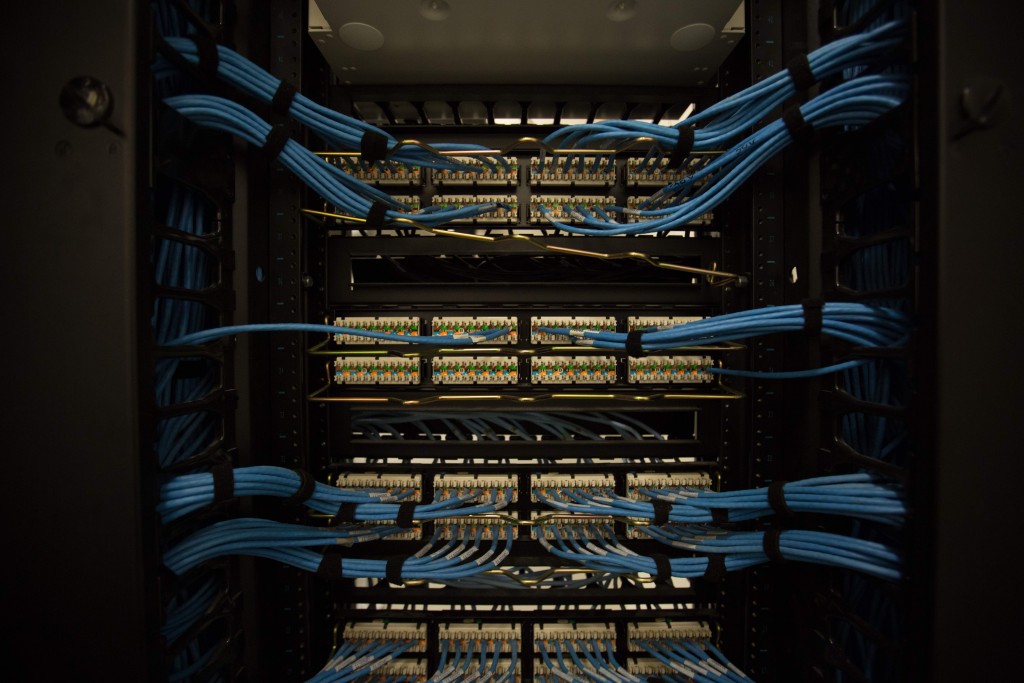
+ Pictured: a data center housed on the Pasadena campus. Jim Rispin, the director of information technology services, sees the servers within it as “a tangible expression of the intangible power of the gospel being lived out by students, staff, and faculty through the ‘ones and zeros’ of their papers, blog posts, and emails.”
REFLECTION
“We tend to think of technology as more science than art, or at least an applied science dependent on art. (Could this be a key for holding arts and sciences together?) Heidegger links techne to a bringing forth, to the notion of poiesis. At its best, technology is a creative act, merging thought with matter and time. Creation can be seen as God’s poetry, the realization of word and image, ideas made manifest.”
+ Craig Detweiler, in his book iGods: How Technology Shapes Our Spiritual and Social Lives. He recently taught Fuller’s DMin course “Theology and Pop Culture.”
“We’re now in a culture that flows through networks, and to understand a people, you need to map the networks they’re a part of. If you drew a circle around my street to understand the people in my neighborhood—and that’s all you looked at—you wouldn’t know us very well. You’d have to study the global networks we’re connected to. . . . We’re sharing emotional space, connected space, completely outside the face to face relationships we have. This is a new aspect of culture we haven’t had before.”
+ Ryan Bolger, associate professor of church in contemporary culture, in a lecture on church communities and technological change.
“The reenchantment of the world is linked to our use of technology. The access to the fruits of modernity, the age of scientific nationalism, is what allows us ultimately to reenchant our lives. Technology, both the written word that perhaps marks the dawning of the modern age and the computer technologies that herald its morphing into a new stage, provides the means by which a bureaucratized culture finds its way back to the mystical.”
+ Barry Taylor, artist in residence at Fuller’s Brehm Center for Worship, Theology and the Arts, in his book Entertainment Theology: New-Edge Spirituality in a Digital Democracy.
“Pastors and Christian educators must consider the fact that students and congregants are not only engaging in Christian formation within the walls of churches and institutions, but also online. . . . Not only are United States citizens being formed by the media- saturated culture they are embedded within, in general, they are participating and socializing online far more than they are participating or socializing in churches or classrooms.”
+ Angela Gorrell [PhD student], from her research on social media and community formation. Hear her interview at The Gathering Place, a resource for Anabaptist youth ministers, on their podcast.
PRAXIS
“Technology at Fuller allows us to think of students and staff in places like Seattle, Phoenix, Houston, and many more around the country and around the world as our neighbors, as part of a community which we call Fuller. My job at Fuller becomes a matter of hospitality, helping create spaces of welcome for people who would otherwise be on the margins of this community. By shrinking the space between us, technology becomes a medium through which we may be present to one another.”
+ Eric Mulligan, Fuller videoconferencing support coordinator
“I’m thrilled when I walk by a Pasadena classroom and see classrooms from our remote campuses made present to each other by our videoconferencing technology. I smile when I see administrators across our campuses communicating synchronously in one of our conference rooms. . . . As Fuller moves forward, the technological possibilities for extending its educational resources to more people, including those less privileged, is a very exciting prospect to me, and I look forward to being a part of that initiative.”
+ “Wall” Wofford, director of Fuller’s technology support services
“We have students connecting from over 60 different countries speaking a number of different languages. Ten years ago, the only way we could bring these people together would have been meeting in a single geolocation, and our faith would have been less rich and less diverse because the distance becomes a debilitating factor. With technology, it is easier and faster to cross borders and bring every person of the Christian faith, no matter their ethnicity, their location, or their resources, together at a single table to teach and learn together.”
+ Jeff DeSurra, instructional designer in Fuller’s distributed learning
“When I was initially approached to teach my course, Pastoral Care and Addictions, via Fuller Live!, I was apprehensive. The class addresses highly sensitive material and includes a great deal of self-disclosure and personal testimonies. I was concerned that due to the distance learning medium, there would be a lack of personal connection, but thankfully this has not been an issue. I have taught my course twice using Fuller Live!, and despite the many miles that have separated us, there has been only respect, unity, and connection among myself and students near and far.”
+ Shannae Anderson, adjunct professor for pastoral care and addiction courses
“Even as a firm believer in online interaction, I know there is often no substitute for face-to-face communication. With that attitude we often eschew some technologies, thinking them to stand in the way of ‘real’ human connection. But it’s worth asking ourselves, perhaps especially in the contexts of ministry or education: Does this tool provide us with a connection we would otherwise not have had?”
+ Cory Piña, online community coordinator for Distributed Learning and developer for The Quad, Fuller’s online student forum

“As a person who builds new technologies, I feel as though the church is standing at the edge of a vast ocean of new connective, potentially faith-transmitting technologies. It can feel overwhelming. But we can temper any fears we might feel with the knowledge that the faith we now hold came to us through earlier technologies. Like the first scribes and the printing-press reformers after them, we have a responsibility, with God’s help, to use the technologies at hand in ways that are both daring and faithful. . . . We need to design systems that pay attention to how that power is forming people—both the good and bad.
Technology has the potential to connect people across the world and quickly communicate ideas and stories that transform our society and individuals in radical ways. And just like working out, when we perceive our training as a game, it’s more fun and we’re more inclined to do it regularly. So we’ve designed an app to empower young people who are looking to develop their character by giving them a path to get there and have some fun while they’re doing it.”
+ Matt Lumpkin, pictured right, is Fuller’s online user experience strategist and developer for the Quad, Fuller’s online student forum. CharacterMe is a mobile app developed by the Thrive Center that combines technology and cognitive behavorial therapy to help teenagers practice emotional regulation while also delivering real-time data to researchers. Read the whole interview here and more about the psychology behind the app here.
“When it comes to the use of digital technology 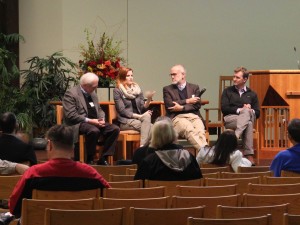 in the church, we should be missional, creative, and faithful. What we do with technology should be motivated and guided by our mission as the people of God called into God’s service for the sake of the world. Our use of technology should also be creative and not merely an imitation of secular patterns and practices. Wouldn’t it be wonderful if the church actually created new technologies that reflect the grace, rhythms, and justice of God? We need to be thinking critically— as well as creatively and prayerfully, in light of Scripture—about these tools God has entrusted to us and all the uses to which we put them.”
in the church, we should be missional, creative, and faithful. What we do with technology should be motivated and guided by our mission as the people of God called into God’s service for the sake of the world. Our use of technology should also be creative and not merely an imitation of secular patterns and practices. Wouldn’t it be wonderful if the church actually created new technologies that reflect the grace, rhythms, and justice of God? We need to be thinking critically— as well as creatively and prayerfully, in light of Scripture—about these tools God has entrusted to us and all the uses to which we put them.”
+ Mark Roberts, director of the Max De Pree Center for Leadership, from his talk “How God Uses Technology for His Purposes” at the Rewiring: Faith and Technology Conference (pictured, middle right). Read more on his daily e-devotional “Life for Leaders.”
“Because of social media, Black Lives Matter has been able to disrupt the public sphere and become a movement with a global scope. The justice issues they address, powered through new social platforms, have resulted in some tangible change. I contend that the church has yet to seize this opportunity. While technology fuels social transformation, the church is largely on the sidelines. What might it look like if we had a platform where . . . truth and theological thought leadership had more followers than Facebook or Instagram? Where we could create a connected Christian church bound by a network of love?”
+ Trustee C. Jeffrey Wright, from his lecture at the Rewiring conference. Wright is executive director of FULLER Studio, a new venture providing formation resources for the global Christian church and individuals seeking a deeply informed spiritual life.
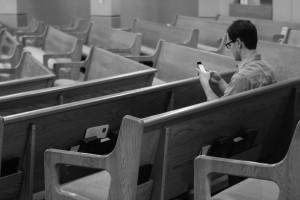 “Conflicts in the church over the use of “technology” in worship rarely have anything to do with technology and often have everything to do with our collective (mis)understanding of the meaning and purpose of worship. For example, some Christians believe that Sunday morning is a time of theological education, others see it as a time for aesthetic entertainment, still others see it as an opportunity for private spiritual enrichment. In the end, Christian communities will purchase and implement liturgical technologies to serve their prospective goals for worship. What we have in the church is not a technology problem—we have a worship problem. Education, aesthetics, and enrichment might all play a proper role in worship but none of them constitute the true end of worship. If the true purpose of worship is the glory of God and the formation of God’s people for mission, we must ask ourselves first and foremost how these liturgical technologies either serve and distract from the people’s worship.”
“Conflicts in the church over the use of “technology” in worship rarely have anything to do with technology and often have everything to do with our collective (mis)understanding of the meaning and purpose of worship. For example, some Christians believe that Sunday morning is a time of theological education, others see it as a time for aesthetic entertainment, still others see it as an opportunity for private spiritual enrichment. In the end, Christian communities will purchase and implement liturgical technologies to serve their prospective goals for worship. What we have in the church is not a technology problem—we have a worship problem. Education, aesthetics, and enrichment might all play a proper role in worship but none of them constitute the true end of worship. If the true purpose of worship is the glory of God and the formation of God’s people for mission, we must ask ourselves first and foremost how these liturgical technologies either serve and distract from the people’s worship.”
+ Matthew Kaemingk, director of Fuller Institute for Theology and Northwest Culture, from his lecture during its recent conference Rewiring: Faith and Technology. Learn more about The Fuller Institute for Theology and Northwest Culture and the companion blog Christ & Cascadia. At right: a conference-goer stays connected during a break between sessions at the conference.
Further Reading
The Digital Invasion: How Technology Is Shaping You and Your Relationships
Archibald Hart and S. H. Frejd (Baker, 2013)
Human Identity at the Intersection of Science, Technology, and Religion
Edited by Nancey Murphy and C. Knight (Ashgate, 2010)
Right Click: Parenting Your Teenager in a Digital Media World
Kara Powell, Art Bamford, and Brad M. Griffin (Fuller Youth Institute, 2015)
Available Classes
The Church in a Culture of Technology with Ryan Bolger
Narrative Communication in a Visual Age with Ken Fong

